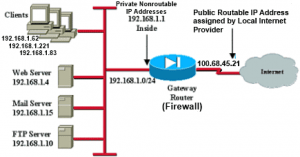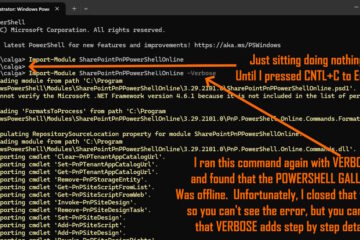Nonroutable IP addresses are the IP’s that are typically used inside a LOCAL Area Network (i.e. your home or office) and cannot have their packets transferred to (or from!) the Internet. Nonroutable addresses were defined by RFC1918 way back in 1996 in an effort to ensure that we don’t run out of addresses (and also does a good deal to keep our internal data, internal, but the RFC does not mention security).
There are only a few blocks of address that are non-routable and they are:
10.0.0.0 – 10.255.255.255 (10/8 prefix) = 16,777,216 addresses in total
172.16.0.0 – 172.31.255.255 (172.16/12 prefix) = 1,048,576 addresses in total
192.168.0.0 – 192.168.255.255 (192.168/16 prefix) = 65,536 addresses in total
 Wait a minute, you may say, I use 192.168.x.x on my network and I can connect to the Internet. How can that be? The answer is your Gateway (your firewall for many small businesses and nearly all home networks) provides something called Network Address Translation or NAT. Basically, your Gateway (firewall) acts as your proxy.
Wait a minute, you may say, I use 192.168.x.x on my network and I can connect to the Internet. How can that be? The answer is your Gateway (your firewall for many small businesses and nearly all home networks) provides something called Network Address Translation or NAT. Basically, your Gateway (firewall) acts as your proxy.
When you make a request (like surfing to the amazing history of Commodore computers at www.Commodore.ca ) your packets flow through your LOCAL network to your Gateway (firewall) and the Gateway connects to the Internet for you, using your PUBLIC IP address (i.e. NOT in the one of the three ranges above). That public IP address is using to route all over the internet and find what you requested (i.e. www.Commodore.ca). When the packets from your request come back to your Gateway (firewall), it looks at a simple Excel type table it maintains to keep track of which computer (local IP address) requested the data, and it forwards the packets to the appropriate computer (local IP address).
In case you still are not getting it, RFC1918 may say it better than I do:
…With the proliferation of TCP/IP technology worldwide, including
outside the Internet itself, an increasing number of non-connected
enterprises use this technology and its addressing capabilities for
sole intra-enterprise communications, without any intention to ever
directly connect to other enterprises or the Internet itself.The Internet has grown beyond anyone’s expectations. Sustained
exponential growth continues to introduce new challenges. One
challenge is a concern within the community that globally unique
address space will be exhausted.…To contain growth of routing overhead, an Internet Provider obtains a
block of address space from an address registry, and then assigns to
its customers addresses from within that block based on each customer
requirement. The result of this process is that routes to many
customers will be aggregated together, and will appear to other
providers as a single route [RFC1518], [RFC1519]. In order for route
aggregation to be effective, Internet providers encourage customers
joining their network to use the provider’s block, and thus renumber
their computers.



0 Comments